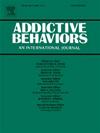The Cannabis Use Disorder Identification Test – Consumption (CUDIT-C) as a targeted tool for cannabis use screening
IF 3.6
2区 医学
Q1 PSYCHOLOGY, CLINICAL
引用次数: 0
Abstract
Objective
This study aimed to evaluate the psychometric properties and predictive utility of the Cannabis Use Disorders Identification Test – Consumption (CUDIT-C), a concise alternative to the Cannabis Use Disorders Identification Test – Revised (CUDIT-R), across individuals with differing levels of cannabis use.
Method
Participants included infrequent (N = 108) and frequent cannabis users (N = 138) from two studies. A confirmatory factor analysis (CFA) was first conducted to test a two-factor model of the CUDIT-R, hypothesizing that the first two items (CUDIT-C) load onto one factor, while the remaining items load onto a second factor related to cannabis dependence and problems. The CUDIT-C and CUDIT-R were then assessed for their ability to predict cannabis-related outcomes, including self-reported use days over the past 30 days and peak plasma delta-9-tetrahydrocannabinol (THC) levels following acute use.
Results
The two-factor model was a stronger fit to the data than the one-factor model. Among infrequent users, the CUDIT-C performed equivalently to the CUDIT-R. In frequent users, the CUDIT-C either matched or outperformed the CUDIT-R, including being a stronger predictor of peak THC levels, an established marker of hazardous cannabis exposure. Conclusion
The CUDIT-C is a practical and effective tool for assessing cannabis use, particularly among frequent users. However, its utility may be limited for infrequent users due to restricted variability of use in this group. Future research should explore its application in clinical settings and diverse populations, as well as its potential for diagnosing cannabis use disorders.
大麻使用障碍识别测试-消费(CUDIT-C)作为大麻使用筛选的目标工具
目的本研究旨在评估大麻使用障碍识别测试-消费(CUDIT-C)的心理测量特性和预测效用,这是大麻使用障碍识别测试-修订(CUDIT-R)的简洁替代方案,适用于不同大麻使用水平的个体。方法纳入两项研究的不常吸食者(N = 108)和常吸食者(N = 138)。首先进行了验证性因子分析(CFA)来测试CUDIT-R的双因素模型,假设前两个项目(CUDIT-C)加载到一个因素上,而其余项目加载到与大麻依赖和问题相关的第二个因素上。然后评估CUDIT-C和CUDIT-R预测大麻相关结果的能力,包括过去30天内自我报告的使用天数和急性使用后的峰值血浆δ -9-四氢大麻酚(THC)水平。结果双因素模型比单因素模型对数据的拟合更强。在不经常使用的用户中,CUDIT-C的性能与CUDIT-R相当。在频繁使用者中,CUDIT-C的表现与CUDIT-R相当或优于CUDIT-R,包括作为THC峰值水平的更强预测因子,THC峰值水平是危险大麻暴露的既定标志。结论CUDIT-C是评估大麻使用情况的一种实用有效的工具,特别是在频繁使用者中。然而,由于这一群体使用的可变性有限,对于不经常使用的用户,其效用可能受到限制。未来的研究应该探索它在临床环境和不同人群中的应用,以及它在诊断大麻使用障碍方面的潜力。
本文章由计算机程序翻译,如有差异,请以英文原文为准。
求助全文
约1分钟内获得全文
求助全文
来源期刊

Addictive behaviors
医学-药物滥用
CiteScore
8.40
自引率
4.50%
发文量
283
审稿时长
46 days
期刊介绍:
Addictive Behaviors is an international peer-reviewed journal publishing high quality human research on addictive behaviors and disorders since 1975. The journal accepts submissions of full-length papers and short communications on substance-related addictions such as the abuse of alcohol, drugs and nicotine, and behavioral addictions involving gambling and technology. We primarily publish behavioral and psychosocial research but our articles span the fields of psychology, sociology, psychiatry, epidemiology, social policy, medicine, pharmacology and neuroscience. While theoretical orientations are diverse, the emphasis of the journal is primarily empirical. That is, sound experimental design combined with valid, reliable assessment and evaluation procedures are a requisite for acceptance. However, innovative and empirically oriented case studies that might encourage new lines of inquiry are accepted as well. Studies that clearly contribute to current knowledge of etiology, prevention, social policy or treatment are given priority. Scholarly commentaries on topical issues, systematic reviews, and mini reviews are encouraged. We especially welcome multimedia papers that incorporate video or audio components to better display methodology or findings.
Studies can also be submitted to Addictive Behaviors? companion title, the open access journal Addictive Behaviors Reports, which has a particular interest in ''non-traditional'', innovative and empirically-oriented research such as negative/null data papers, replication studies, case reports on novel treatments, and cross-cultural research.
 求助内容:
求助内容: 应助结果提醒方式:
应助结果提醒方式:


